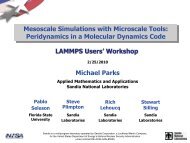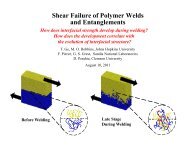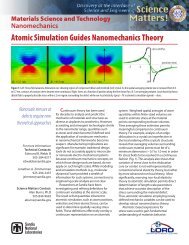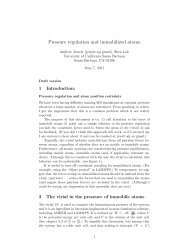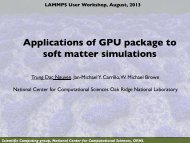Dynamics Of Entangled Polymers: Using LAMMPS For Large Scale
Dynamics Of Entangled Polymers: Using LAMMPS For Large Scale
Dynamics Of Entangled Polymers: Using LAMMPS For Large Scale
Create successful ePaper yourself
Turn your PDF publications into a flip-book with our unique Google optimized e-Paper software.
<strong>Dynamics</strong> of <strong>Entangled</strong><strong>Polymers</strong>: <strong>Using</strong> <strong>LAMMPS</strong> for<strong>Large</strong> <strong>Scale</strong> SimulationsGary S. GrestSandia National LaboratoriesAlbuquerque, NMSandia is a multiprogram laboratory operated by Sandia Corporation, a Lockheed Martin Company,for the United States Department of Energy’s National Nuclear Security Administrationunder contract DE-AC04-94AL85000.
<strong>Large</strong> Time/Length <strong>Scale</strong> Simulations• Many systems one needs large times and length scales– <strong>Polymers</strong>, Membranes, Proteins, Nanoparticles– Acceleration algorithms are sometimes useful for structurebut rarely for dynamics• Step 1 Coarse grain – reduces number of atoms by ~ 10 andincrease time steps from fs to ps• Step 2 Build initial state – sometimes easy/sometimes not• Step 3 Run for a long time on as many processors as possible– Number beads > 500/processsor
Bead-Spring Model• Short range - excluded volumeinteractionr c =2 1/6 σ, 2.5σ• Bonded interaction - FENE springk=30ε/σ 2 , R o =1.5σ• Energy barrier prohibits chains from cutting through each other– topology conserved• Chain stiffness can be included by addition of three-body terms• MD – velocity-Verlet, time step 0.010 - 013τ
Advancement Hardware/SoftwarePast 25 Years• Modified scalar code (Rahman)• Vector MD – 4 processor Cray XMP – late 1980’s– 10 4 monomers – 10 million time steps• Shared Memory – SGI cluster – 1990’s– 4-8 processors• Parallel MD Code – <strong>LAMMPS</strong> – late-1990’s to present– 256-2048 processors – Intel and Sun Clusters most recent studies– ½ to 1 million monomers – 1-2+ billion time steps– 5 million monomers – 300+ million time steps• WARNING – time_step > 2.14 billion steps bad thingshappen with <strong>LAMMPS</strong>
Displacement of <strong>Entangled</strong> PolymerInner monomers500 chainsN=500• 100, 000 processor hours
Stress Relaxation - Melt• Relaxation after elongation – λ= 2, 3, 4 (red, green, blue)StressN e from PPA+ end-to-enddistance• N=1000– similar results• N=3500– reach plateauN=350 N=700t/τC. Svaneborg et al.,PRL (submitted)• Relaxation time independent of λ. same terminal relaxationtime for all 3 quantities• Experimental Strains – λ=1.01 to 1.05t/τ
Self-Healing of Polymer Films• Development of Entanglements Across an Interface20 kτ 700 kτ 1.5 Mτ100x40x100σ 3700 kτ 1.5 MτF. Pierce, D. Perahia, GSG
How Fast Does a Crack Heal?4.8 millionmonomers3.5 millionsteps/day1024 coresLongest run –2.5 millionnode hoursMass Uptake, Penetration Depth z ~ 1/2
Healing Depends on Motion of Chain EndsOuter monomersAll monomersInner monomers• Chain ends move much faster, resulting in much fasterself-healing then predicted by theory
Entanglements at Interface• Primitive Path Analysis– Contact all chains simultaneously with ends fixed– (n dec – 1) new beads are placed between adjacent beadson the original chains and process repeated - n dec =450σt=0 700kτ 1.5MτR. Everaers et al., Science 303, 823 (2004); R. Hoy and G. S. Grest, Macromolecules 40, 8389 (2007).
Future Directions• Outlook for computer modeling is exciting– Faster, cheaper computers– Efficient parallel MD codes• <strong>Large</strong>r Systems, Longer Chains, Longer Times• Smaller strain, shear rates– Viscosity– Relaxation after shear• Constraint Release - Polydispersity• Semidilute polymers – explicit solvent• Primitive Path <strong>Dynamics</strong> – Melts/Networks• Branched <strong>Polymers</strong>, Stars, ….
Acknowledgement• Department of Energy – Contract No. ER46456• Center for Integrated Nano Technologies – Sandia• New Mexico Computer Applications Center
Viscoelasticity of <strong>Entangled</strong> Polymer MeltStress Relaxation G(t) after strain• Macroscopic– Intermediate frequency, timepolymer melt acts as a solid– Long time, low frequencypolymer acts as a liquid• Microscopic– Gaussian coils, R ~ N 1/2– Stress is due to entropy lossof stretched chains– <strong>Polymers</strong> as "entropicsprings"– Stress relaxation due toBrownian motion oftopologically constraint chains
What contributes to interdiffusion?• Chain ends dominate early time interdiffusion• Rouse motion of chain ends leads to faster mass uptake






